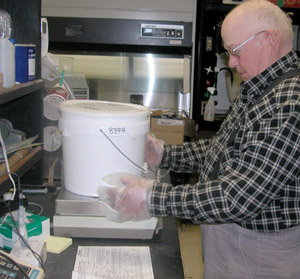By Sharon Omahen
University of Georgia
Jerry Walker thinks Georgia does a great job controlling
emissions. And he should know. Twenty-five years ago he set up a
monitoring site that analyzes chemicals in the state’s rainfall
that contribute to acidic rain.
Now an emeritus professor with the University of Georgia,
Walker
set up the first long-term wet-deposition monitoring site in
Georgia in 1978. The site was at a UGA College of Agricultural
and Environmental Sciences farm in Pike County.
Now one of six in Georgia, the site is part of a 250-site
network
run by the National Atmospheric Deposition Program. Many sources
fund the NADP, including state agricultural experiment stations,
universities, industries and federal agencies.
Analyzing the nation’s rain
The sites collect rain and snow samples across the nation.
Scientists analyze them weekly for their chemical makeup. The
lower a substance’s pH, the more acidic it is.
“By measuring and analyzing the rain, we can determine its
long-term effects on agricultural crops, forest and the
environment,” Walker said. “The monitoring system allows us to
track the chemistry of storms and evaluate potential impacts of
new sources of emissions.”
John Melin, an engineering program specialist, has collected
the
rain samples at the UGA site from the beginning. Every Tuesday
morning, Melin and site operators across the nation collect,
weigh and measure the pH of samples from their sites. Then they
mail a subsample to the national office in Champaign, Ill., for
further analysis.
“Acid rain was a big concern in the 1970s,” Walker said. “But
you
have to realize that normal rain has a pH level of 5.6, so it’s
always a little on the acidic side. That’s because the carbon
dioxide in the air creates carbonic acid, which dissolves into
the rain.”
Levels vary from state to state
Pure water has a pH of 7.0. In 2000, the most acidic rain in
the
United States had a pH of 4.3, according to the U.S.
Environmental Protection Agency.
In 2001, southwestern Ohio’s pH was 4.4. The Pike County,
Ga.,
site’s pH was 4.8, Walker said. “It’s really hard to compare pH
levels, as they vary. It could be 4.3 in Pennsylvania and 5.5 in
California.”
Acid rain is worse in the Northeast and Midwest than in
Georgia,
he said.
“That’s because of the emission of gases from the power plants
… burning coal for fuel,” he said. “This creates a lot of
sulfur dioxide, which leads to sulfuric acid in the rain.”
Scientists have confirmed that sulfur dioxide and nitrogen
oxides
are the main causes of acid rain. The EPA reports that two-thirds
of all sulfur dioxide and one-fourth of all nitrogen oxides in
the United States come from electric power generation.
In Georgia, an estimated 26.7 percent of the sulfur emitted by
utility units is returned through precipitation, Walker said.
Plants benefit from the sulfur
“Scientists have long recognized the importance of this
element
to plant growth,” he said. “In some locations, sulfur is added to
deficient soils.”
Walker said he’s pleased with his 25 years of monitoring
precipitation in Georgia. “Our state panned out a lot better than
I thought it would in the beginning,” he said.
“But that’s because we’ve made changes,” he said. “We’ve added
controls to our smoke stacks and decreased our auto emissions.
Georgia’s a lot better off than some other states. So it’s not
all doomsday like you often hear.”
The goal of the national program is to pinpoint problems and
record long-range trends.
“The program’s data shows that, in general, things are better
now
than they were when the monitoring program was first started,”
Walker said.
To view the program’s findings, visit the
(nadp.sws.uiuc.edu).




